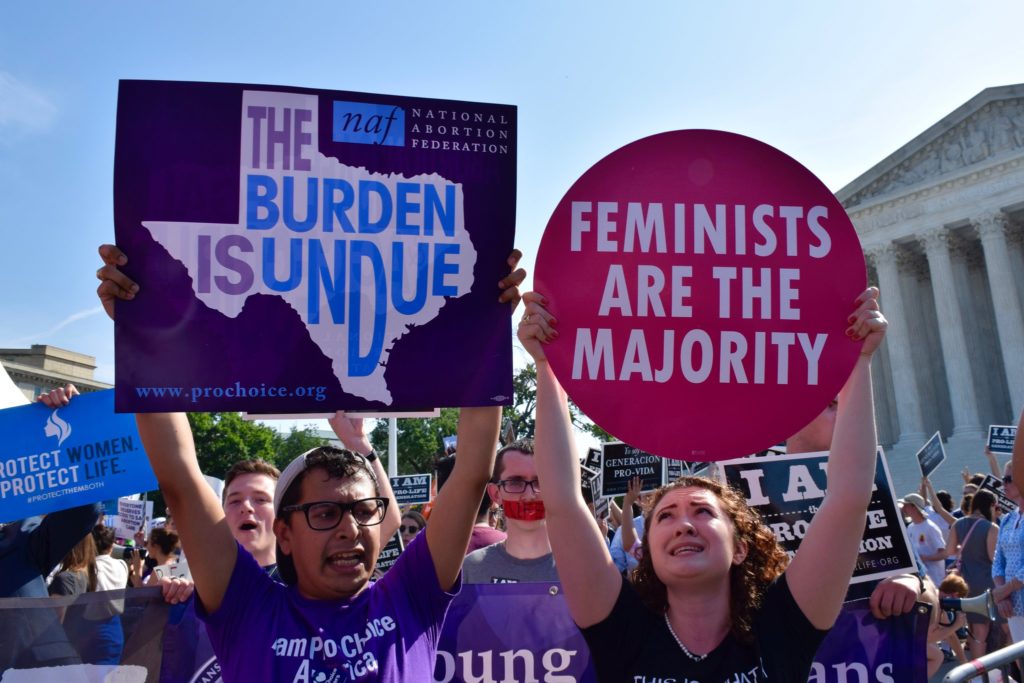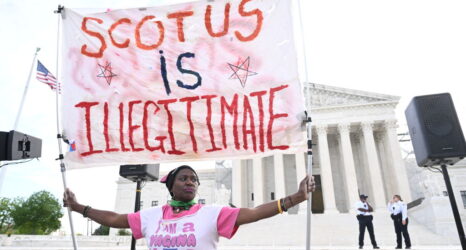On a crisp spring day in March 2016, hundreds of women and men throughout the United States congregated outside the Supreme Court as oral arguments took place inside regarding the case Whole Woman’s Health v. Hellerstedt, which challenged two Texas laws that targeted abortion providers.
One required that clinics retro-fit to become ambulatory surgical centers, and the other required doctors to obtain hospital admitting privileges. Both laws were challenged as violating the basic tenets of Roe v. Wade and Planned Parenthood v. Casey, because they posed undue burdens on a woman’s right to terminate a pregnancy. Ultimately, the Supreme Court ruled that neither law related to health and safety as Texas legislators claimed.

Admitting privileges were hard to obtain, the Court decided, and ultimately unnecessary. Justice Breyer pointed to the case of one doctor who had delivered more than 15,000 babies and yet could not obtain admitting privileges—and, because abortions are incredibly safe procedures, where death and injuries are extremely rare, there was no justification for requiring clinics to spend millions of dollars to acquire the status of ambulatory surgical centers. A woman is at greater risk of injury and death receiving a colonoscopy than an abortion.
But women’s health and safety were crafty political proxies, not the true focus of targeted regulations of abortion providers—TRAP laws. The laws emerged from aggressive attempts by the male dominant Texas legislature to hobble, gut and ultimately upend abortion rights in that state.
When then Governor Rick Perry signed the legislation into law, he victoriously predicted it would make abortion “a thing of the past” in Texas. Perry and Texas legislators cleverly erected so many barriers in the paths of women seeking abortions in Texas so as to render the right to terminate a pregnancy more illusory than real. In combination, these laws would result in the closure of half of the abortion clinics in Texas. According to Perry, he was upholding the “culture of Texas.” But, how was placing women’s lives at risk the proud “culture” of a state, even Texas? How could exploiting women’s vulnerabilities and coercing them into futures they would not choose be part of the culture of Texas?
In part, Perry was right. Sadly, the culture of Texas has been fraught for women, one where husbands could legally rape their wives until just two decades ago. In 2016, nearly 150 women were murdered by their male partners in Texas, and there were nearly 20,000 reported cases of sexual assault. This level of violence cannot be blamed on alcohol, drugs, or strangers: Nearly 85 percent of the reported sexual assaults had nothing to do with mind-altering substances, and 73 percent of the incidents happened in a home. Texas is second in the nation for calls to domestic violence hotlines.
Within a few short years after Perry signed HB2, Texas would become the deadliest place in the developed world for a pregnant woman. The maternal mortality rates would soon skyrocket in Texas as more clinics closed and it became difficult for women to gain access to contraceptives, medical screenings, abortions and prenatal care. The rates of unintended pregnancies would rise along with the unplanned, Medicaid-funded births.
According to the Texas Policy Evaluation Project, within months of the law’s enactment, the number of abortion clinics in Texas dramatically declined by 56 percent—from 41 licensed clinics to 18. After the bill’s passage, researchers marked a dramatic uptick in the number of women who sought to self-induce abortions, estimating that between 100,000 to as many as a quarter of a million women in Texas had attempted them.
The laws were not about keeping Texas women safe, because abortions are one of the safest procedures a woman could possibly undergo. In the United States, a woman is more likely to die from cancer, diabetes, pneumonia and influenza, suicide and nephritis than an abortion. A woman is also more likely to die from domestic violence, gun death, drug poisoning or homicide than from a legal abortion.
Unlike the false narratives touted by the Texas legislature, abortions are very safe. For decades, the World Health Organization has compared the safety of abortions to penicillin shots. Empirical research, ultimately cited by the Supreme Court in Whole Woman’s Health, shows that a person is 14 times more likely to die by carrying a pregnancy to term than by having an abortion. In Texas, relative to abortion, pregnancy is a killer.
For Black women, maternal mortality is frightening. They are nearly four times more likely to die by carrying a pregnancy to term than their white counterparts. In states like Texas, Mississippi and Louisiana, pregnancy can be a death-sentence for women of color, especially Black women. With the closure of Texas abortion clinics, those whose lives became most at risk were poor women—who, because of the horrific combination TRAP laws in Texas, would be forced to drive hours for medical attention related to an abortion and wait sometimes several days before retuning. Mandatory wait periods, forced vaginal ultrasounds and being subjected to hearing false information from medical providers, are part of the cornucopia of TRAP Laws intended to delay and discourage women from terminating pregnancies.
On that frigid morning in March, competing bullhorns and imagery demarked the political divide of the crowds. Abortion opponents brandished placards of highly magnified fetuses. Some among their group hurled prayers, omens, threats and epithets.
Like a fish in the broad sea, I was one among the multitudes concerned about the future of reproductive health, rights and justice in our country. On my side, the signage said it all: “Keep Clinics Open,” “Protect Abortion Access,” “Stop The Sham.” Together, we stood in the chilly, morning cold, blowing puffs of warmth into our hands, painfully aware of how much was at stake in this case and bearing witness to the growing chaos surrounding well-established, fundamental rights to reproductive privacy in our country.
By 2016, reproductive rights had indeed become vulnerable, in part due to backlash against President Barack Obama, which manifested in the rise of a neo-conservative, predominantly white political movement known as the Tea Party. They swept into office, riding on a tide resentments that resonated with vulnerable and evangelical populations in their states. The economic downturn, which was not caused by President Obama, was nonetheless his to fix and to some of them, his fault. Despite heroic efforts on the economic front, including restoring an economy wreaked by unjustified wars, communities upended by the financial crisis, were still hurting.
Perhaps to them, the Tea Party was a means to their salvation. Even then, they misjudged.
Few commentators at the time associated the Tea Party’s sweep into office with racial backlash against Barack Obama, ignoring the grotesque, stereotypic imagery on display outside of the white house, in right-wing publications, and on the internet depicting President Obama in racialized, misogynistic Black male tropes. One such image was of Obama aggressively hurling a frightened and remonstrating Michelle Obama by the collar and buttocks onto a baseball field; the caption read that he was throwing out “the first pitch.” There were almost too many of the derogatory cartoons, caricatures and even websites devoted to racist propaganda to keep track.
The earliest signs of the blatant racism started with clever attempts to protest the Patient Protection and Affordable Care Act, which mandated contraceptive coverage in health plans—with signs caricaturing the president with a huge bone through the nose. On Facebook, there were calls to assassinate the president and “his monkey children.” Then there were the hot-selling $3 bumper stickers urging Obama not to “Re-Nig” and racial throw-back t-shirts, depicting Obama as a monkey eating a banana or watermelon and the chilling Sean Delonas’s cartoon of police killing a crazed chimpanzee. The caption refers to the chimp as author of the stimulus bill. The stereotypic racist imagery was endless; the president shining Sarah Palin’s shoes, Michelle Obama as an aging monkey.
Race and racism played a critical role in what brought these crowds to the steps of the Supreme Court, even if they did not realize it. As the Tea Party swept into office, gutting reproductive rights was high on their agenda. They were successful. During the period 2010-2013, more anti contraception, abortion, and sex education laws were proposed and/or enacted in state legislatures than in the prior three decades combined.
These dehumanizing laws ranged from abortion waiting periods extended up to 72 hours, not including weekends and holidays. In Iowa, a bill requiring that the governor sign off on each Medicaid funded abortion was signed into law. In Wisconsin, women seeking abortions were required to undergo unnecessary vaginal ultrasounds, legalizing the state’s penetration of women’s bodies. In Michigan, lawmakers banned all insurance providers from covering abortions, including in cases of rape and incest. Some states began enacting laws to criminalize pregnant women’s unbefitting conduct.
The rise of the Tea Party marked Bei Bei Shuai’s arrest and prosecution in Indiana for first degree murder in the wake of her attempted suicide while pregnant. Meanwhile, in Iowa, Christine Taylor was arrested for falling down steps while pregnant. Alicia Beltran was confined against her will for more than 70 days by the state of Wisconsin and denied an attorney, although one was appointed for her fetus. In Texas, the body of Marlise Munoz, a brain-dead, decomposing woman, was forced to gestate a barely developing fetus. In Alabama, women were, and continue to be, arrested for “endangering” their fetuses.
From a broader perspective, the Tea Party’s agenda was not only to upend reproductive rights, but to inflame anti-immigration sentiment, suppress voting rights and challenge the growing concerns about global warming. Some legislators went so far as to claim climate change was an illusion, a figment of scientific imagination.Their agenda was to thwart the advancement of any policy platforms coming out of the White House, even if it would benefit their constituents.
It worked.
However, this was not the legacy of the Republican Party. It certainly did not reflect the bold and brilliant legacy of Justice Harry Blackmun, author of the 7-2 majority opinion in Roe v. Wade. Blackmun, appointed by Richard Nixon was a Republican.
Nor was it consistent with the efforts of former president, George H.W. Bush, who as a member of Congress shepherded Title X through that legislative body. Title X provides reproductive health care for the poorest Americans and was signed into law by Richard Nixon. Shortly after signing the legislation, President Nixon remarked that it was common sense to promote reproductive healthcare. It was public health.
In the time since Dr. Martin Luther King, Jr. received Planned Parenthood’s inaugural Margaret Sanger Award and Prescott Bush, father of George H.W. Bush, served as the Treasurer for Planned Parenthood, much has changed.
In June 2016, when the Supreme Court issued its 5-3 opinion in Whole Woman’s Health, striking down the two Texas laws, Justice Breyer was resoundingly clear that the Texas laws violated the constitutional safeguards established in Planned Parenthood v. Casey. The Court found that both the admitting privileges law and the surgical center requirements placed substantial obstacles in the path of women seeking abortions. The laws constituted an undue burden on abortion access. As such, they violated the Constitution.
Within in a year of the Supreme Court’s ruling in Whole Woman’s Health, in a highly unusual move, state legislators began promulgating laws identical to those struck down by the Court. In Minnesota, legislators proposed an ambulatory surgical center law. In Louisiana, lawmakers and ultimately the Fifth Circuit Court of Appeals refused to give deference—as required by law—to the Supreme Court’s ruling on admitting privileges. To place this in context, imagine that within a year of Brown v. Board of Education, school districts across the country instituted policies to enshrine segregation, claiming the Supreme Court case was not applicable to their states, and only applied to Topeka, Kansas.
This year, the Court will evaluate a challenge to Whole Woman’s Health when the Court hears June Medical Services v. Gee, a case with a virtually identical law to the Texas admitting privileges statute. In Louisiana, lawmakers argue it’s not the law that will harm women’s access to abortions, but that doctors are to blame. The state speciously claims that its law cannot be governed by the outcomes in Texas. If clinics close in Louisiana, they assert it will be because doctors are too lazy to obtain the necessary admitting privileges.
Even while the challenge is nothing short of a brazen disregard for constitutional precedent and the rule of law, there is much to be concerned about. For one, the Court has changed since the summer of 2016. Justice Kennedy, a key vote in Whole Women’s Health, has resigned from the Court, now replaced by Justice Brett Kavanaugh. Justice Gorsuch, appointed in the wake of Justice Scalia’s death has long opposed women’s reproductive rights.
What the case will come down to, as with so much occurring with U.S. domestic and foreign policy, is the integrity of our institutions—and in this case the United States Supreme Court. Can the Court have respect for the rule of law and its own jurisprudence?





